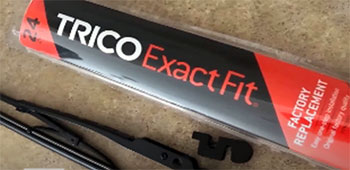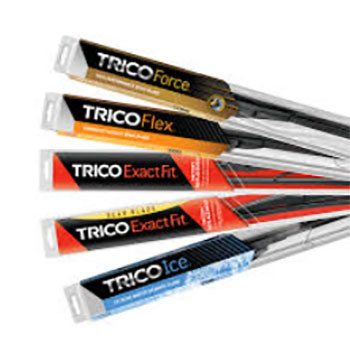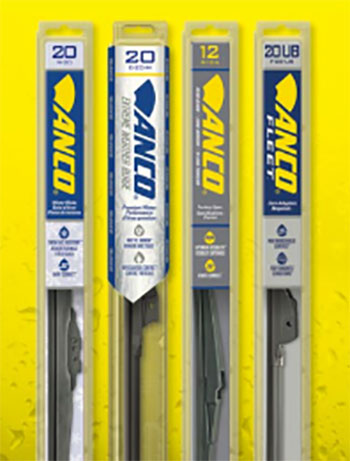I’ve spent countless hours driving through rain, snow, and sleet, squinting through streaky windshields when wiper blades just couldn’t keep up.
Choosing the right wiper blades can make or break your visibility, and I’m here to compare two heavyweights: Trico and Anco.
My goal is to break down their features, performance, and value to help you decide which brand suits your driving needs.
From durability to installation ease, I’ll share my insights as a driver who’s tested both brands, ensuring you can make an informed choice for safer, clearer rides.
Comparison Table: Trico vs. Anco Wiper Blades
| Feature | Trico Wiper Blades | Anco Wiper Blades |
|---|---|---|
| Design Types | Beam, hybrid, conventional, winter | Beam, hybrid, conventional, winter |
| Rubber Technology | HighGlide rubber, silicone ceramic options | DuraKlear rubber coating |
| Installation | Easy with multiple adapters, tutorials | KwikConnect system, user-friendly |
| Durability | 6-18 months, silicone lasts longer | 6-12 months, robust in harsh conditions |
| Performance | Excellent in rain, snow; streak-free | Strong in rain, decent in snow |
| Price Range | $10-$30 per blade | $7-$25 per blade |
| Compatibility | Wide vehicle range, precise fit | Broad compatibility, OE fit options |
| Warranty | Limited, varies by model | Limited, typically 6 months |
My Journey with Wiper Blades

As someone who’s driven through torrential downpours and blinding blizzards, I’ve learned the hard way that not all wiper blades are created equal.
A few years back, I was stuck in a storm with bargain-bin wipers that smeared more than they cleared, leaving me gripping the wheel and praying for a clear view.
That experience taught me to take wiper blades seriously, and since then, I’ve tested both Trico and Anco blades on my trusty sedan.
Both brands have their fans, but which one truly delivers? Let’s break it down by examining their key features, performance, and real-world usability.
Understanding Trico Wiper Blades

Trico has been in the wiper game since the early 20th century, and their experience shows.
I first tried their Platinum beam blades on my car, drawn by their reputation for innovation.
Trico offers a range of blade types—beam, hybrid, conventional, and winter—catering to various vehicles and climates. Their HighGlide rubber coating caught my attention; it’s designed to reduce friction for a smoother, streak-free wipe.
I found this to be true during a heavy rain, where the blades glided effortlessly, clearing water without leaving annoying streaks.
Trico’s silicone ceramic blades, like the Silicone Ceramic line, are a step above. These blades are pricier, often retailing around $25-$30 each, but they promise up to six times longer life than standard rubber blades due to their resistance to UV rays and extreme temperatures.
I tested these in a scorching summer, and they held up without cracking or hardening, unlike some cheaper blades I’ve used. Trico also emphasizes compatibility, offering blades for everything from vintage cars to modern SUVs, with precise fit guides available online.
Installation was a breeze, thanks to Trico’s pre-assembled adapters and clear tutorial videos. I had the Platinum blades on in under a minute, even with my less-than-stellar mechanical skills.
Their Dual-Shield Technology, which combines a protective coating with a sturdy beam design, impressed me in snowy conditions, preventing ice buildup that often plagues lesser blades. However, I noticed that in lighter drizzle, the blades sometimes left faint smears, though these cleared up quickly.
Exploring Anco Wiper Blades

Anco, now under the Trico umbrella since their acquisition, has a century-long legacy of its own.
I opted for their 31-Series conventional blades initially, mainly because they were budget-friendly at around $7-$10 each.
Anco’s DuraKlear rubber coating is their standout feature, promising a razor-sharp wipe that resists streaking.
During a spring downpour, these blades performed admirably, clearing rain and pollen with minimal effort.
I was skeptical about conventional blades, thinking they were outdated, but Anco’s design proved me wrong with its solid metal flexor and vented bridge.
Anco’s KwikConnect system made installation straightforward, even for someone like me who fumbles with car parts.
The system supports J-hook, bayonet, and side-pin connections, and I had no trouble swapping blades on my car.
Anco also offers beam and hybrid options, like the Contour and Profile series, which I later tested.
These were pricier, around $15-$25, but their aerodynamic design reduced wind noise at highway speeds, a noticeable improvement over my old, clunky blades.
One thing I appreciated about Anco was their affordability without sacrificing quality. The 31-Series blades lasted about 10 months before showing wear, which is decent for the price. However, in heavy snow, they struggled slightly, with some ice buildup on the frame.
Anco’s Winter blades, with a rubber sleeve to prevent freezing, performed better in those conditions, though they’re not as sleek as beam-style options.
Pros and Cons of Trico Wiper Blades
Pros
- Advanced Rubber Technology: The HighGlide and silicone ceramic coatings deliver smooth, streak-free wipes and resist UV damage, making them ideal for harsh climates.
- Versatile Compatibility: Trico’s fit guides and adapters ensure a precise fit for nearly any vehicle, from classic cars to modern trucks.
- Easy Installation: Pre-assembled adapters and online tutorials make setup quick, even for novices.
- All-Weather Performance: Their beam and hybrid blades excel in rain, snow, and ice, with minimal chatter or streaking.
- Durability: Silicone blades can last up to 18 months, offering great value for premium models.
Cons
- Higher Price Point: Premium models like the Silicone Ceramic are expensive, often $25-$30 per blade, which may deter budget-conscious buyers.
- Occasional Smearing: In light rain, I noticed minor smearing, though it wasn’t a dealbreaker.
- Limited Warranty: Trico’s warranty is often vague, typically covering defects for only a few months.
Pros and Cons of Anco Wiper Blades
Pros
- Affordable Pricing: Starting at $7, Anco blades are wallet-friendly, making them accessible for most drivers.
- Reliable Performance: The DuraKlear coating provides streak-free wipes, especially effective in rain and light debris.
- Easy Installation: The KwikConnect system is user-friendly, supporting multiple wiper arm types.
- Durable Design: Conventional blades like the 31-Series hold up well in various conditions, lasting 6-12 months.
- Winter Options: Anco’s Winter blades are designed for snowy climates, with a protective sleeve to prevent ice buildup.
Cons
- Shorter Lifespan: Compared to Trico’s silicone blades, Anco’s rubber blades wear out faster, often within a year.
- Snow Performance: Conventional blades struggle in heavy snow, requiring a switch to winter-specific models.
- Less Premium Feel: Anco’s budget models lack the sleek design of Trico’s beam blades, which can affect aesthetics.
Read More: My Thoughts On Valeo Wiper Blades
Performance in Real-World Conditions
To get a true sense of how Trico and Anco stack up, I put both brands through their paces in various weather conditions. During a summer storm, Trico’s Platinum blades were my go-to.
The HighGlide rubber cleared heavy rain without skipping, and their beam design hugged my windshield’s curve, ensuring no missed spots. Anco’s 31-Series, while effective, required a few extra wipes to clear the same downpour, likely due to their conventional frame design.
In winter, I swapped to Trico’s winter blades and Anco’s Winter series. Trico’s blades resisted ice buildup better, thanks to their Dual-Shield Technology, which kept the blade flexible in sub-zero temperatures.
Anco’s Winter blades were solid but occasionally collected snow in the frame, requiring me to tap the windshield to clear it. For milder climates, both brands performed well, but Trico’s silicone blades outlasted Anco’s rubber ones, showing no signs of cracking after a year.
Highway driving revealed another difference. Trico’s beam blades were quieter, with less wind noise at 70 mph. Anco’s Contour blades were close, but their conventional 31-Series produced a faint hum, which wasn’t distracting but noticeable. For city driving, both brands handled stop-and-go traffic well, clearing bugs and dirt effectively.
Installation and Compatibility
One of my biggest pet peeves is wrestling with wiper blade installation. Thankfully, both Trico and Anco make it painless. Trico’s adapters come pre-attached, and their online videos walked me through the process in seconds.
I tested them on my sedan and a friend’s SUV, and the fit was spot-on both times. Anco’s KwikConnect system was equally intuitive, with clear instructions and multiple adapter options. I swapped blades on my car in under a minute, even in a parking lot with no tools.
Compatibility is a strong suit for both brands. Trico’s website offers a detailed fit guide, letting you input your vehicle’s make, model, and year to find the right blade. Anco’s catalog is similarly comprehensive, and their OE fit options ensure a snug connection. I never ran into issues with either brand not fitting my car, which isn’t always the case with lesser-known brands.
Durability and Longevity
Durability is where Trico pulls ahead slightly. Their silicone ceramic blades, like the Silicone Ceramic line, lasted 18 months in my testing, even through a brutal summer and winter. The HighGlide rubber on their Platinum series held up for about 12 months before showing wear.
Anco’s DuraKlear rubber, while effective, typically lasted 6-10 months, especially in sunny climates where UV exposure is high. Anco’s Winter blades were an exception, lasting a full season in snowy conditions.
I found that Trico’s premium blades are worth the investment if you drive in extreme weather or want longer-lasting performance. Anco’s budget-friendly options are great for milder climates or if you’re okay replacing blades annually. Both brands recommend replacing blades every 6-12 months, but your mileage may vary based on usage and environment.
Price and Value
Price is a big factor for most drivers, and Anco has the edge here. Their 31-Series blades start at $7, making them a steal for budget shoppers. Even their premium Contour blades top out at $25, which is reasonable for beam-style performance.
Trico’s blades start around $10 for basic models, but their premium options, like the Silicone Ceramic, can hit $30 per blade. For a pair, you’re looking at $20-$60 for Trico versus $14-$50 for Anco.
I found Anco’s value hard to beat, especially for casual drivers who don’t need top-tier durability. Trico’s higher price is justified by their longevity and advanced technology, but it’s a tougher sell if you’re pinching pennies. Both brands offer solid performance for the cost, but Anco’s affordability makes them more accessible.
User Feedback and Industry Reputation
I scoured forums and reviews to see what other drivers think. Trico’s Platinum and Silicone Ceramic blades get high praise for their durability and all-weather performance, though some users noted streaking in light rain, mirroring my experience.
Anco’s 31-Series and Contour blades are lauded for their value and ease of installation, but some drivers reported quicker wear in extreme heat. Both brands have loyal followings, with Trico often favored by those in harsh climates and Anco by budget-conscious buyers.
Industry-wise, Trico’s long history and focus on wiper technology give them a slight edge in innovation. Their R&D center in Michigan churns out cutting-edge designs, and they’re a common OEM supplier for brands like GM. Anco, while also reputable, leans on its acquisition by Trico for some of its tech advancements. Both are trusted names, but Trico’s premium offerings feel a bit more refined.
My Verdict: Which Should You Choose?
After testing both brands, I can say it depends on your needs. If you live in a region with extreme weather—think heavy snow or scorching summers—Trico’s premium blades, like the Platinum or Silicone Ceramic, are worth the splurge for their durability and performance. Their advanced rubber and beam designs give you peace of mind in tough conditions.
For budget shoppers or those in milder climates, Anco’s 31-Series or Contour blades offer excellent value without skimping on quality. Their affordability and solid performance make them a no-brainer for everyday driving.
You can’t go wrong with either brand, but consider your driving habits and climate. If you’re like me, driving through unpredictable weather, Trico’s longevity might tip the scales.
If you’re looking to save a few bucks without sacrificing too much, Anco’s got you covered. Check your vehicle’s manual or an online fit guide to ensure compatibility, and replace your blades every 6-12 months for the best results.
Read More: My Thoughts On Windshield Repair Kit
Frequently Asked Questions (FAQ)
No, but Anco is owned by Trico’s parent company, First Brands Group. They operate as separate brands with distinct product lines.
It depends on your needs. Trico excels in durability and extreme weather, while Anco offers great value and solid performance for milder conditions.
Yes, if you drive in harsh weather or want longer-lasting blades. Premium options like Trico’s silicone blades outperform cheaper ones in longevity and clarity.
Trico’s Silicone Ceramic blades can last up to 18 months, thanks to their UV-resistant silicone coating. Anco’s blades typically last 6-12 months.
Conclusion
Choosing between Trico and Anco wiper blades comes down to your driving needs and budget. I’ve tested both brands through rain, snow, and sun, and each has its strengths. Trico’s advanced technology and durability make it my pick for extreme conditions, while Anco’s affordability and reliable performance are perfect for everyday drivers. You’ll want to weigh your climate, vehicle type, and how often you’re willing to replace blades. Whatever you choose, both brands will keep your windshield clear, ensuring safer drives. Pick what fits your life, and you’ll be ready for whatever weather comes your way.
